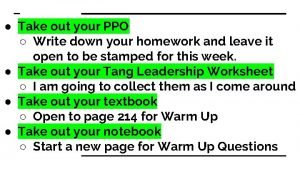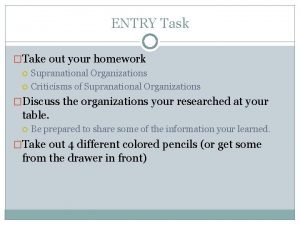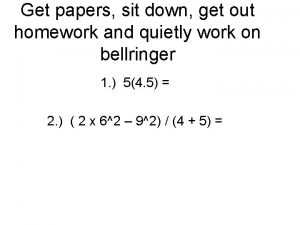Get out your homework and materials for notes


















- Slides: 18

�Get out your homework and materials for notes! �If you have your parent letter signed and/or supplies, please place it on my desk.

CHAPTER 4: Designing Studies 4. 2 Experiments

Experiments ü ü ü ü ü DISTINGUISH between an observational study and an experiment. EXPLAIN the concept of confounding. IDENTIFY the experimental units, explanatory and response variables, and treatments in an experiment. EXPLAIN the purpose of comparison, random assignment, control, and replication in an experiment. DESCRIBE a completely randomized design for an experiment. DESCRIBE the placebo effect and the purpose of blinding in an experiment. INTERPRET the meaning of statistically significant in the context of an experiment. EXPLAIN the purpose of blocking in an experiment. DESCRIBE a randomized block design or a matched pairs design for an experiment. The Practice of Statistics, 5 th Edition 3

Observational Study vs. Experiment An observational study observes individuals and measures variables of interest but does not attempt to influence the responses. An experiment deliberately imposes some treatment on individuals to measure their responses. When our goal is to understand cause and effect, experiments are the only source of fully convincing data. The distinction between observational study and experiment is one of the most important concepts in statistics.

Observational Study vs. Experiment Observational studies of the effect of an explanatory variable on a response variable often fail because of confounding between the explanatory variable and one or more other variables. Well-designed experiments take steps to prevent confounding. Confounding occurs when two variables are associated in such a way that their effects on a response variable cannot be distinguished from each other. AP Tip: If you are asked to identify a possible confounding variable, you must: 1. Explain how it is associated with the explanatory variable. 2. explain how it affects the response variable.

Check Your Understanding, p. 237 1. Does reducing screen brightness increase battery life in laptop computers? To find out, researchers obtained 30 new laptops of the same brand. They chose 15 of the computers at random and adjusted their screens to the brightest setting. The other 15 laptop screens were left at the default setting—moderate brightness. Researchers then measured how long each machine’s battery lasted. Was this an observational study or an experiment? Justify your answer. Experiment, because a treatment (brightness of screen) was imposed on the laptops.

Check Your Understanding, p. 237 Does eating dinner with their families improve students’ academic performance? According to an ABC News article, “Teenagers who eat with their families at least five times a week are more likely to get better grades in school. This finding was based on a sample survey conducted by researchers at Columbia University. Was this an observational study or experiment? Justify your answer. Observational Study because students were not assigned to eat a particular number of meals with their family per week.

Check Your Understanding, p. 237 Does eating dinner with their families improve students’ academic performance? According to an ABC News article, “Teenagers who eat with their families at least five times a week are more likely to get better grades in school. This finding was based on a sample survey conducted by researchers at Columbia University. What are the explanatory and response variables? Explanatory: number of meals per week eaten with family Response: GPA

Check Your Understanding, p. 237 Does eating dinner with their families improve students’ academic performance? According to an ABC News article, “Teenagers who eat with their families at least five times a week are more likely to get better grades in school. This finding was based on a sample survey conducted by researchers at Columbia University. Explain clearly why such a study cannot establish a cause-andeffect relationship. Suggest a variable that may be confounded with whether families eat dinner together. There are probably other variables that influence the response variable. For example, students who have part-time jobs may not be able to eat many meals with their families and may not have much time to study, leading to lower grades.

Ants Can Count � http: //www. youtube. com/watch? v=7 DDF 8 WZ Fno. U

The Language of Experiments Here is the basic vocabulary of experiments: A specific condition applied to the individuals in an experiment is called a treatment. If an experiment has several explanatory variables (factors), a treatment is a combination of levels of these factors. The experimental units are the smallest collection of individuals to which treatments are applied. When the units are human beings, they often are called subjects.

Example, p. 239 � What are the effects of repeated exposure to an advertising message? The answer may depend on both the length of the ad and on how often it is repeated. An experiment investigated this question using 120 undergraduate students who volunteered to participate. All subjects viewed a 40 -minute television program that included ads for a digital camera. Some subjects saw a 30 second commercial; others, a 90 -second version. The same commercial was shown either 1, 3, or 5 times during the program. After viewing, all the subjects answered questions about their recall of the ad, their attitude toward the camera, and their intention to purchase it.

What are the effects of repeated exposure to an advertising message? The answer may depend on both the length of the ad and on how often it is repeated. An experiment investigated this question using 120 undergraduate students who volunteered to participate. All subjects viewed a 40 -minute television program that included ads for a digital camera. Some subjects saw a 30 -second commercial; others, a 90 -second version. The same commercial was shown either 1, 3, or 5 times during the program. After viewing, all the subjects answered questions about their recall of the ad, their attitude toward the camera, and their intention to purchase it. For the advertising study, identify the experimental units or subjects, explanatory and response variables, the factors, and the treatments. Experimental Subjects: 120 undergraduate students Response variables: recall of the ad, attitude about the digital camera and whether they intend to purchase it

What are the effects of repeated exposure to an advertising message? The answer may depend on both the length of the ad and on how often it is repeated. An experiment investigated this question using 120 undergraduate students who volunteered to participate. All subjects viewed a 40 -minute television program that included ads for a digital camera. Some subjects saw a 30 -second commercial; others, a 90 -second version. The same commercial was shown either 1, 3, or 5 times during the program. After viewing, all the subjects answered questions about their recall of the ad, their attitude toward the camera, and their intention to purchase it. For the advertising study, identify the experimental units or subjects, explanatory and response variables, the factors, and the treatments. Factor B: Repetitions (Explanatory variable) Factor A: 30 -sec Length (Explanatory Variable) 90 -sec 1 time 3 times 5 times Treatment 1 Treatment 2 Treatment 3 Treatment 4 Treatment 5 Treatment 6

For the advertising study, identify the experimental units or subjects, explanatory and response variables, the factors, and the treatments. 3 levels Factor B: Repetitions Factor A: Length 1 time 3 times 5 times 30 -sec Treatment 1 Treatment 2 Treatment 3 90 -sec Treatment 4 Treatment 5 Treatment 6 2 levels Treatment 5 = 90 -sec commercial 3 times during the program.

For the advertising study, identify the experimental units or subjects, explanatory and response variables, the factors, and the treatments. Factor B: Repetitions Factor A: Length 1 time 3 times 5 times 30 -sec Treatment 1 Treatment 2 Treatment 3 90 -sec Treatment 4 Treatment 5 Treatment 6 Hint: # of treatments = # levels for Factor A x # of levels for Factor B EX: 2 x 3 = 6

How to buy happiness � http: //www. ted. com/talks/michael_norton_h ow_to_buy_happiness

Homework – Due Tuesday � P. 259 #45, 46, 48, 50, 54
 Songs with poetic techniques
Songs with poetic techniques Get into get out of
Get into get out of Take out your homework
Take out your homework Checked homework
Checked homework Take out your homework
Take out your homework Take out your homework
Take out your homework Take out your homework
Take out your homework Write down your homework
Write down your homework Take out your homework
Take out your homework Take out your homework
Take out your homework Supranational organization examples
Supranational organization examples Take out your homework
Take out your homework Homework oh homework
Homework oh homework Homework oh homework i hate you you stink
Homework oh homework i hate you you stink Parts of a poem
Parts of a poem Homework oh homework jack prelutsky
Homework oh homework jack prelutsky Alitteration definition
Alitteration definition The zebras cried when the wise old elephant died
The zebras cried when the wise old elephant died Go noodle cant stop the feeling
Go noodle cant stop the feeling


































